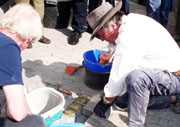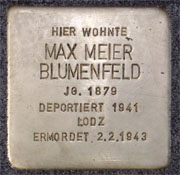News
Right now we are devoting much of our time and energy to a project called "Stolpersteine" (=stumbling blocks) for former Jewish citizens of Bad Hersfeld. So far we have been able to install 43 such memorial stones, each costing 120 €uro. We are confident we can find sufficient sponsors for more of them which are meant to honor and remember those who lost their lives in the Holocaust. Almost all of these victims do not have a gravesite. As some sort of compensation a concrete cube that is covered in brass with the name of the victim and his or her fate is installed into the sidewalk in front of the person’s last known residence. "Stolpersteine are a metaphor for the Germans stumbling over this part of their past—something that won't go away—and that was the artist's point," says James E. Young of the University of Massachusetts at Amherst, author of two books on Holocaust memorialization. "Stolpersteine don't exist in places where you have to make your pilgrimage. You suddenly come upon them." With the stolpersteine everybody sees that things happened in their neighborhood. They realize that there were people who lived in their house or even in their apartment." "It's very important not to lose the remembrance of this special part of German history.
2013 Hassia Judaica
2013 Hassia Judaica


